
Patmos / Πάτμος
The Cave of the Apocalypse
I would go to the Cave of the Apocalypse
my first morning on Patmos.
The ferry terminal is a little to the right of the sailboat
in the picture above.
I was staying at Villa Zacharo about 200 meters inland
from there.
The Monastery of the Cave of the Apocalypse is the lower of
the two large white buildings about halfway from the port town
of Skala to the large monastery on the horizon at upper left.
First, though, I would walk around the harbor and to the
top of the hill overlooking the harbor and the larger
peak topped by the Monastery of Saint John the Theologian.
That's where I took the picture above.
I'll be at
Ιερό
Κάθισμα
Παναγίας
Κουμάνας
or the Holy Seat of Panagia Koumanas, shown on the map below.
From this viewpoint I would return to Skala and
make my way up the hill to the Cave of the Apocalypse.
Here is the view from the balcony off my room at Villa Zacharo. The Monastery of Saint John the Theologian is at the peak. It's the large dark fortress surrounded by the white buildings of Hora.
The large white building to its right, slightly below the crest, is the Patmiada School, a theological school associated with the Monastery of Saint John the Theologian.
The multi-story structure further down the slope, just above the nearby building, is the Monastery of the Apocalypse, built around the cave. It has been built up since the eleventh century, with additions and modifications continuing today, growing into a complex of small churches, chapels, and monastic cells. That's where I'll be going on my first day on Patmos.

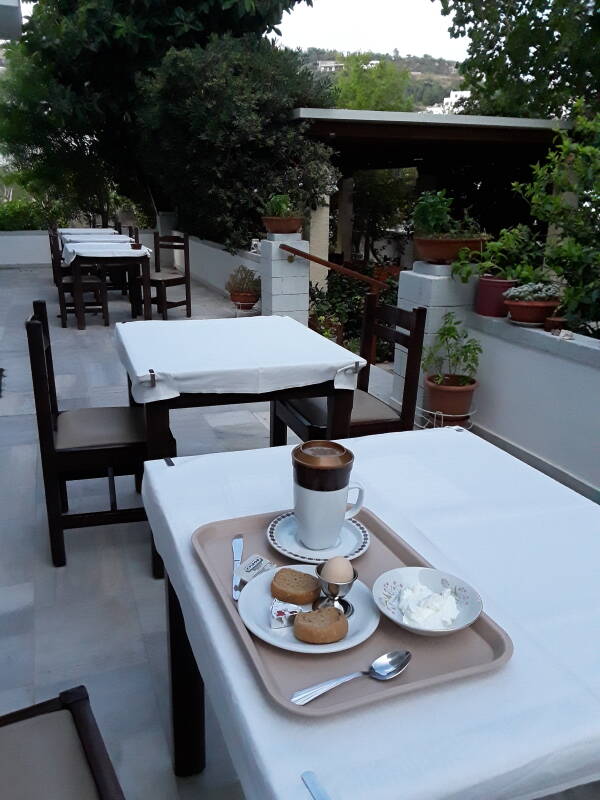
But first, breakfast at my guesthouse. A boiled egg, bread and butter, cheese, and yogurt. And, fresh-brewed coffee.
Over breakfast and a second coffee I could plan my route and review some background reading. For example, just who is John the Theologian?
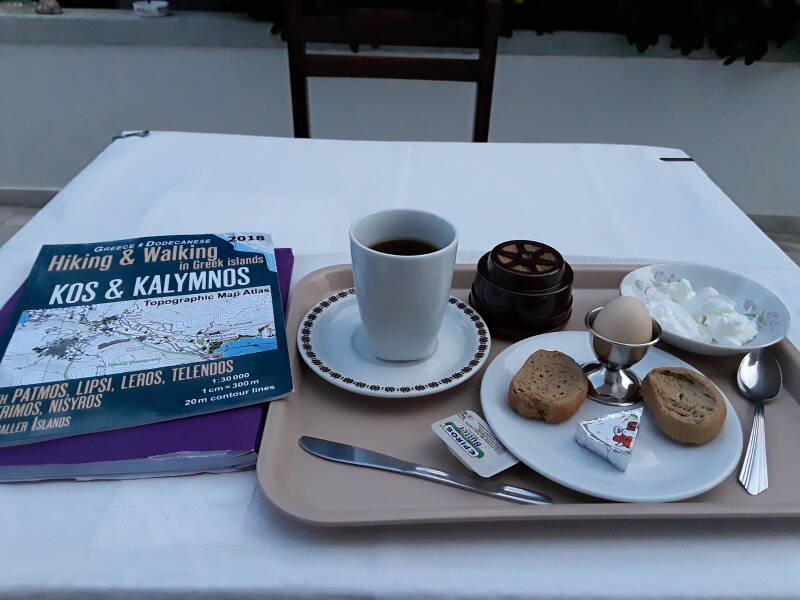
Who is John?
The Revelation of Saint John the DivineThe simplified version of the story is that the Romans exiled John from Ephesus to Patmos, where he wrote Revelation, or as it's sometimes called, The Revelation of Saint John the Divine or other variations.
The real story is much more complicated, and it still provokes debate. For example: How many Johns were there? The candidates include:
- John the Apostle, son of Zebedee, a Galilean fisherman who became one of Jesus' initial twelve disciples. He brother was James, another disciple. Together they were called the "Sons of Thunder". Tradition says that John was the youngest disciple, and was the only one to die of old age. He is said to have died at Ephesus some time after 98 CE, during the reign of Trajan, and to have been buried on a nearby hill now in the small town of Selçuk where a basilica was later erected. Tradition also says that the mother of John and James was Salome, sister of Jesus' mother Mary, making them cousins of Jesus.
- John the Theologian, who wrote the fourth Gospel of the New Testament, commonly called The Gospel of John.
- John the letter writer, who wrote three letters included in the New Testament and commonly called the First, Second, and Third Epistle of John.
- John of Patmos, who wrote Revelation. He was exiled to Patmos during a time of persecution under the rule of Roman Emperor Domitian in the late first century. Domitian ruled 81–96 CE. The evidence tends to confirm that this was when and where Revelation was written, with the majority of scholars favoring a date around 95, toward the end of Domitian's rule.
- "The disciple whom Jesus loved", mentioned six times in the Gospel of John. That Gospel attributes itself to being the message of John the Apostle, although it might have been written down by a group of his followers. But it never specifies just who that "beloved disciple" was.
- John who lived around Ephesus after around 33 CE, caring for Jesus' mother Mary as instructed to do so at the crucifixion.
The over-simplified version you might encounter in a Sunday school class is that they were all the same guy. At the other end of the debate, at least the first five and possibly the sixth were all different people. Or possibly groups of people in the cases of authorship. The Wikipedia article on the authorship of the Johannine works seems like a good introductory overview of part of the problem, with plenty of links to authoritative resources. It has been debated since about 200 CE, especially so since the Enlightenment. One issue is that an uneducated Aramaic-speaking fisherman of Galilee wouldn't have known the sophisticated (to varying degrees) Greek of any of the written works.
Locally, John the Theologian and John of Patmos are definitely considered to be the same person, and that generally also includes John the letter writer. That is, the same person or group wrote all New Testament books attributed to John.
Of course "John" is the English version of the name. You see Ιωάννης or Ioannis, often prefixed with Άγιως, pronounced Ayos, or an abbreviation, meaning "Holy" or "Saint".
Today's secular scholars feel that the author of Revelation probably wasn't the author of the fourth Gospel, as the writing is quite different. Revelation is so different that it was among the last books accepted into the Christian biblical canon. Eusebius' Church History from around 330 CE reports that some accepted it but others did not, and in 348 Cyril of Jerusalem did not include it in a list of canonical books. The Council of Laodicea in 363 did not include it in its list. In the second half of the fourth century it gradually came to be included in lists of the canon.
I checked the schedules for the monastery and the cave. Both were open 0800–1330 every day, plus 1600–1800 Sundays, Tuesdays, and Saturdays.
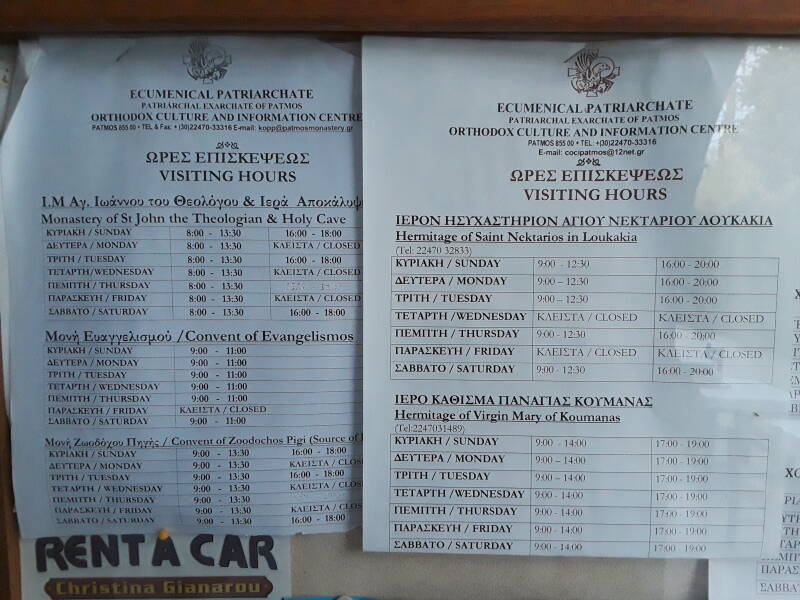
Around the Harbor to the Holy Seat of Panagia Koumanas
Here I go, out the front door of Villa Zacharo.
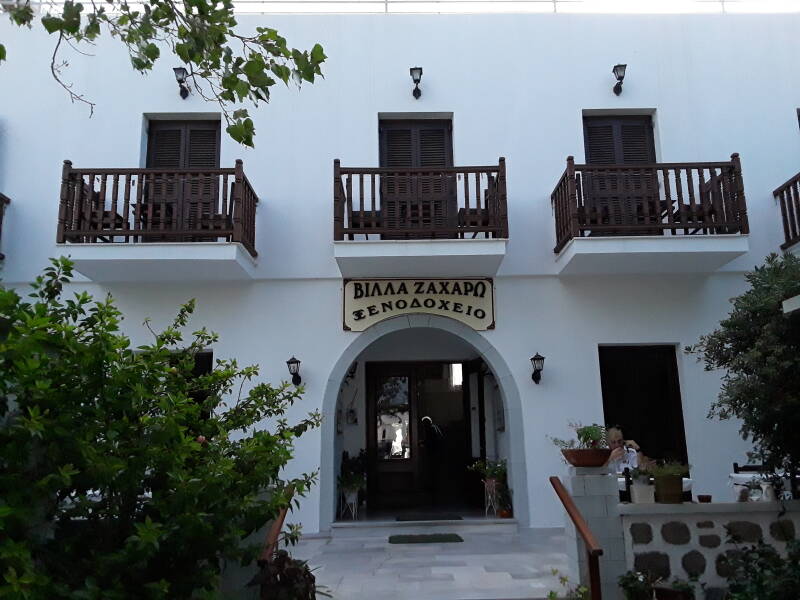
I walked down to the waterfront and started around the harbor. This fisherman has been out and returned, and is cleaning up.
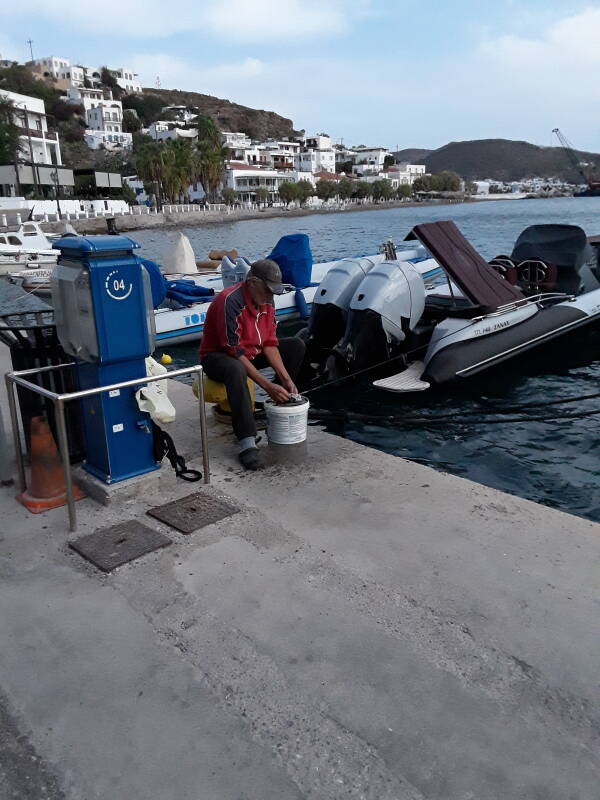
Looking back along the waterfront I see Skala, the monastery at the Cave of the Apocalypse above Skala, and the Monastery of Saint John the Theologian and the Hora settlement at the peak.
The usual pattern on a Greek island is that the main town is named Χώρα or Hora or Chora, which simply means "Town". If the port is a separate settlement, it usually has a name that means "Port" or "Harbor" or similar. Learn those names and you're ready for most islands. But not all of them.
On Patmos the Hora is at the peak, but the port is named Σκάλα or Skala, meaning "Stairs", given that it's at the bottom end of a steep path up to the most important sites.
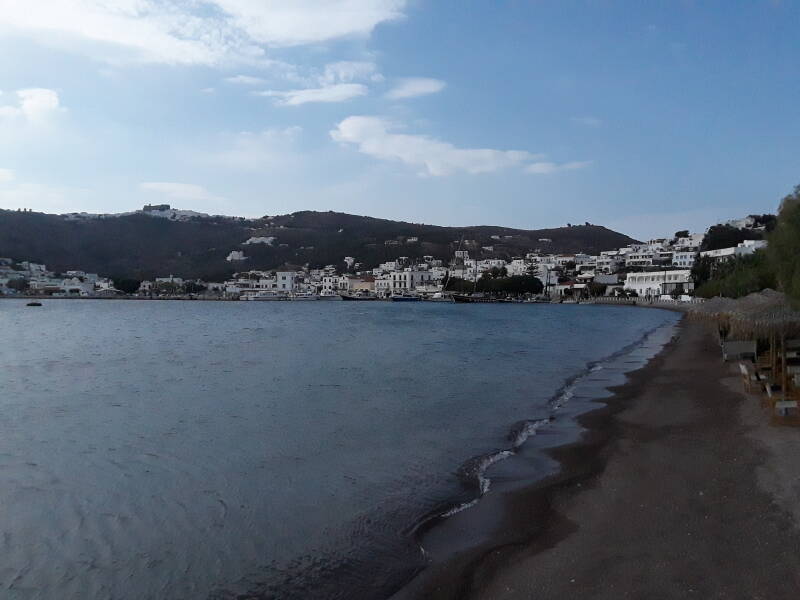
Several fishing boats operate out of Patmos.
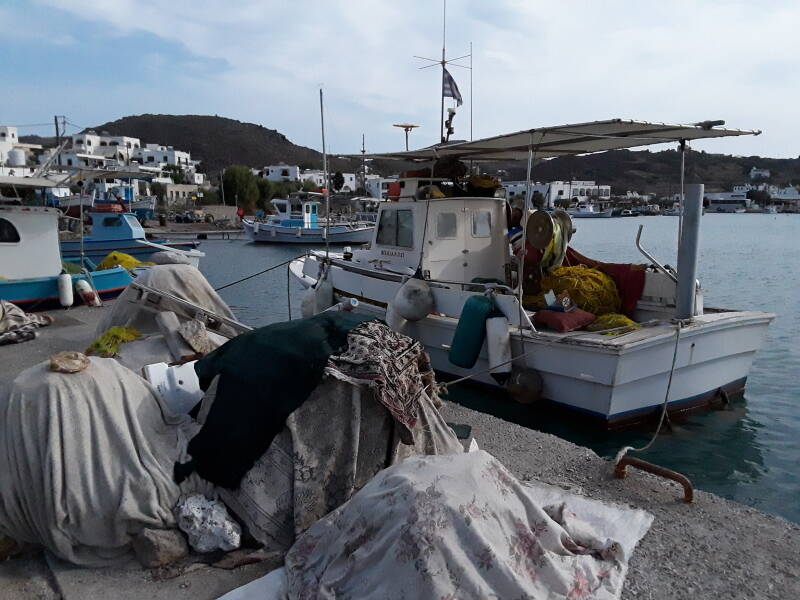

Ιερό Κάθισμα Παναγίας Κουμάνας or the Holy Seat of Panagia Koumanas is a monastery at the peak of the hill on the northeast side of the harbor. It was founded in 1748, one of several "Holy Seats" that the Monastery of Saint John the Theologian founded on Patmos. They're generally built on sites of simple hermitages. This one was originally a hermit's small cave. There's a great view from there.

Stopping at a Chapel
Headed back down to the harbor and Skala, I passed a small church and stopped to visit it. Google Maps will explain, unhelpfully, that it's the Παρεκκλήσια.
Well, παρεκκλήσια or parekklesia simply means "chapel". This one has three small naves, each with its own altar.
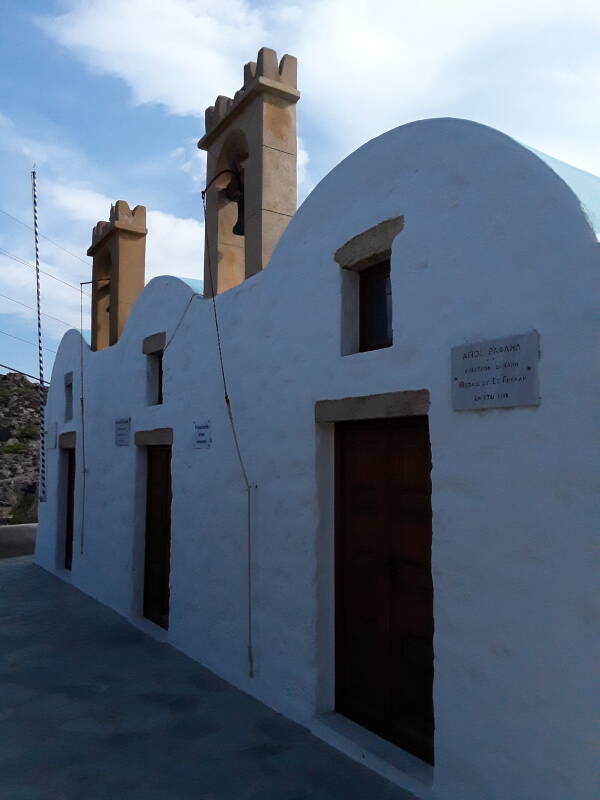
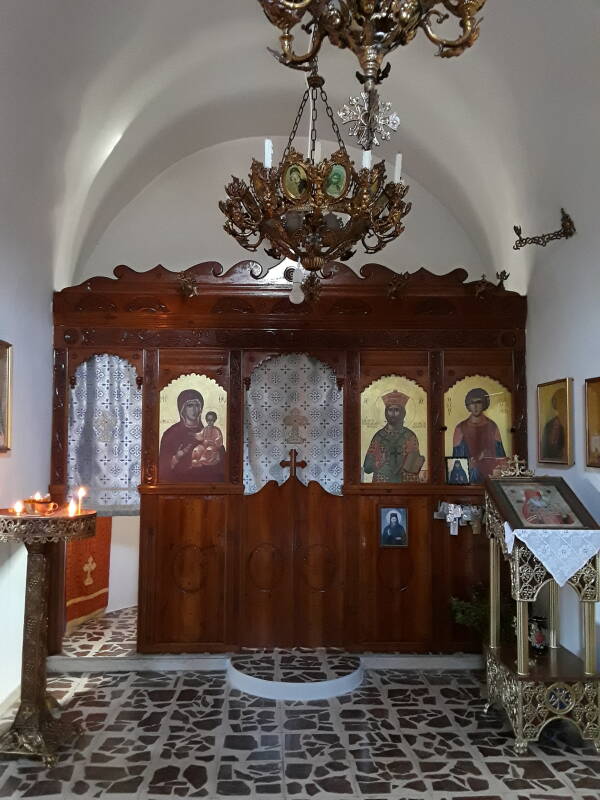
For further details, see the paper "Icons in Theory and Practice" by Margaret E. Kenna, History of Religions, vol 24, no 4 (May 1985), pp 345-368. Also see the book The Meaning of Icons by Leonid Ouspensky and Vladimir Lossky, St Vladimir's Press, 1982.
The είκονοστάσιον or iconostasis divides the nave, where the worshippers stand, from the altar area. It's based on the curtain dividing off the Holy of Holies within the Temple in Jerusalem. A large church will have a tall iconostasis with several rows of icons arranged in a specific order.
The central door or Beautiful Gate is generally kept closed. The priest moves through it during a service. Especially at the Anastasis or Resurrection service at Easter when he comes out of it bearing a large bundle of lit candles. The side doors or Deacons' Doors are used for routine access. In a small chapel there will be just one of everything.
In this minimal chapel, there are still the three primary icons with a lower row of small icons. To the left of the central door is always the Παναγία or Panagia, depicting the Θεοτόκος or Theotokos, the God-Bearer Virgin Mary, holding baby Jesus in a specific pose. To the right is always the Χριστός Παντοκράτωρ or Khristos Pantokrator, "Christ Almighty" or "Christ All-Powerful". The idea is that the first and second comings of Christ always flank the central door to the altar area.


Above are the three primary icons in the second nave.
Here's a closer look at the Kristos Pantokrator in the second nave.
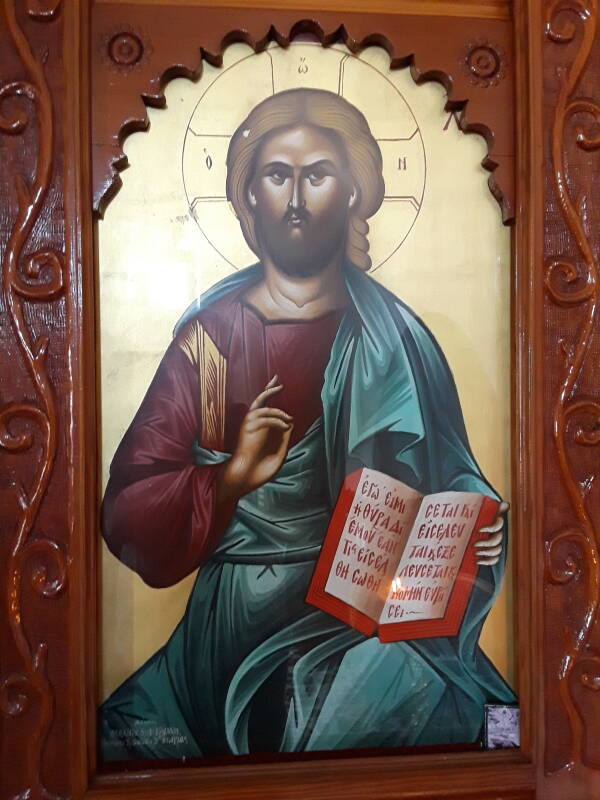

The third icon depicts the person or people to whom the chapel is dedicated. Above is John the Baptist.
Primary figures in icons often have one hand in a specific gesture. It reminds me of what you see in representations of the Buddha, where the many Mudrā gestures have specific meanings such as "Do not fear", "Offering a boon", "Touching the earth", and so on. John the Baptist above is doing something very close to the the Karana Mudrā gesture of Buddhism and the Sign of the Horns that heavy metal bands lifted from Italian grandmothers.
I was curious enough to send some letters to the curators at some museums with significant icon collections: Do Christian icon hand gestures have specific meanings similar to those of Buddhist art, and if so, what are they?
The answers were all along the lines of: "That's an excellent question, but no, they don't. If the gesture involves three fingers together, or two fingers plus the thumb, assume that refers to the concept of the Trinity. But otherwise they're general blessing gestures."
Below is a variation of Khristos Pantokrator, with "King of Kings and Great Archbishop".
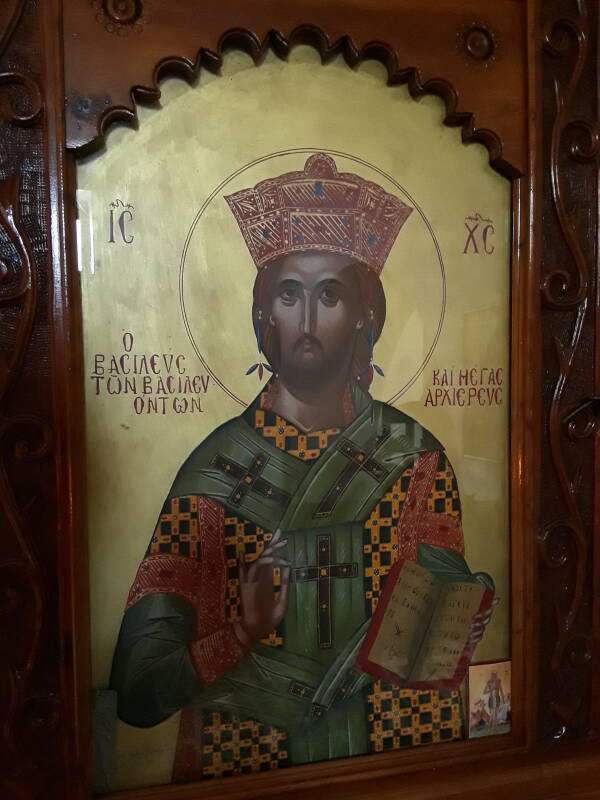
Electricity and the Baptistry
Returning around the harbor, I passed the Patmos electrical plant.
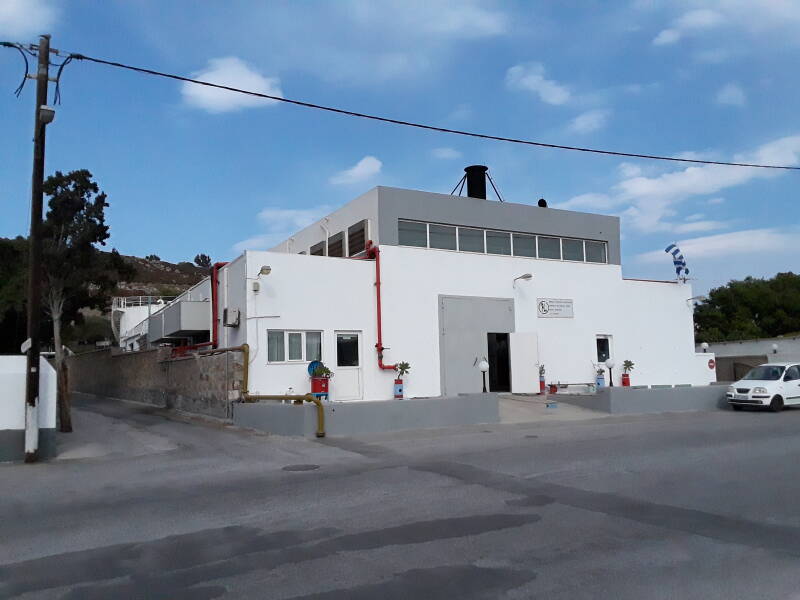
Some projects are making progress toward HVDC undersea transmission lines to carry electrical power from the mainland and between islands. But at the time of this visit, most islands still relied on small generating plants.
A small wall fragment along the road is protected by an iron fence.
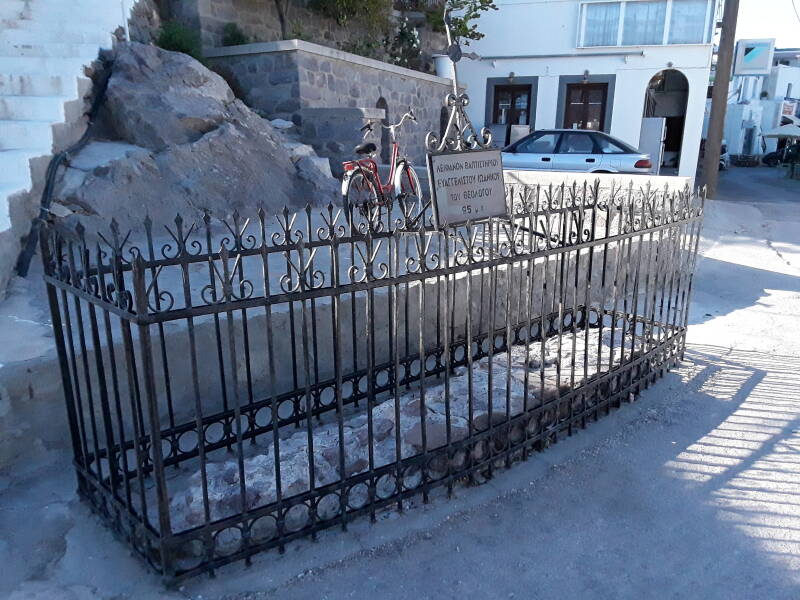
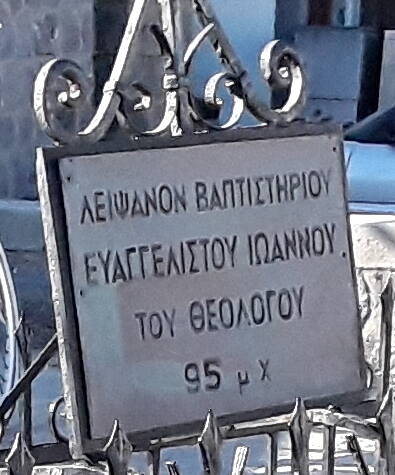
Λείψανον βαπτιστηρίου Ευαγγελιστού Ιωάννου του Θεολόγου 95 μΧ
Remains of the baptistry of Saint John the Theologian 95 AD
It's thought to be a remaining fragment of a baptistry used by John the Theologian in 95 CE.

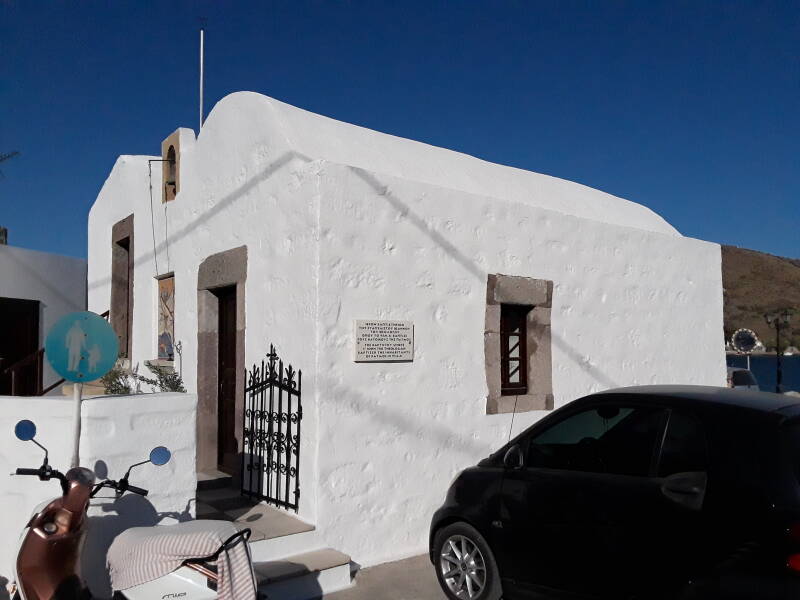
A modern chapel next to the wall fragment has a mosaic depicting Το θανμα του αγιου Ιωαννου του θεολογου or The Death of Saint John the Theologian. There he is baptizing the locals in the foreground, and with his assistant in the background with the hand of God reaching out of the sky. I don't see how this depicts his death, though. But there it is in the mosaic, το θανμα, the same root as the names of Aimée Thanatogenos in The Loved One and Thanos in the Marvel universe.
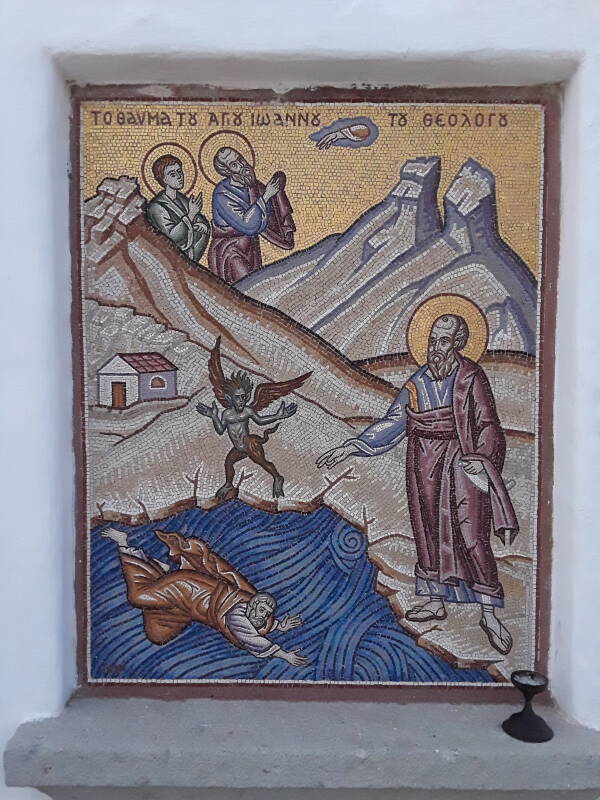
And yes, the "O with horns", the very last character
across the top of that mosaic, represents the pair
of characters
ου
or
ΟΥ,
the dipthong pronounced as "ooh".
That last word is:
ΘΕΟΛΟΓΟΥ
As in "of the Theologian"
I asked the waitress at a cafe about this, because I had just seen it in some ecclesiastical settings and now it had appeared on the wrapper of the ginger cookie accompanying my coffee. And thus a very authoritative source has told me: It represents ου.
Unicode strangely lacks this crucial icon-and-cookie-wrapper glyph.
Some more of the cafes were opening as I passed back through.

To the Cave of the Apocalypse
I returned to the port area and headed south on the main road past where I was staying. As the road started up the hill, a sign pointed off to the left along a path.
Χώρα or Hora, and Σπήλαιο της Αποκάλυψης or the Cave of the Apocalypse.
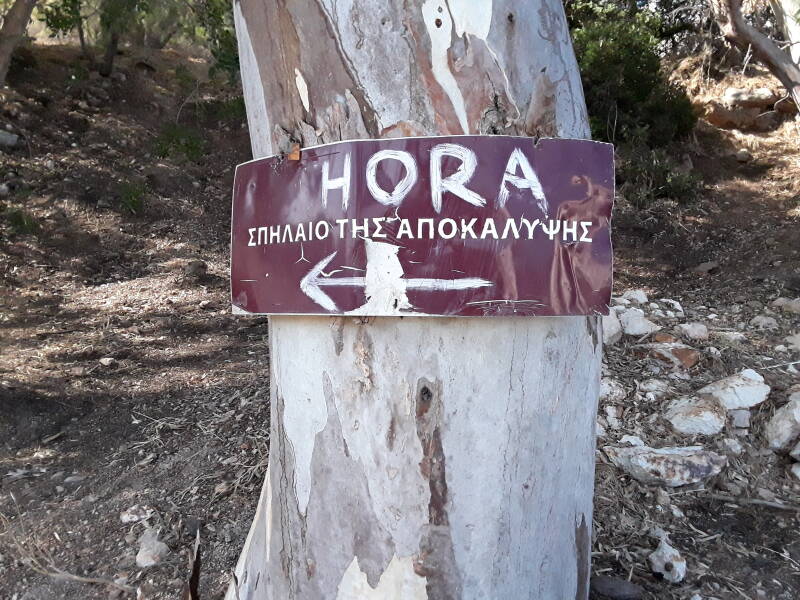
Here I go up the path. A monastery complex surrounds the Cave of the Apocalypse, it's the multi-level white structure on the left.
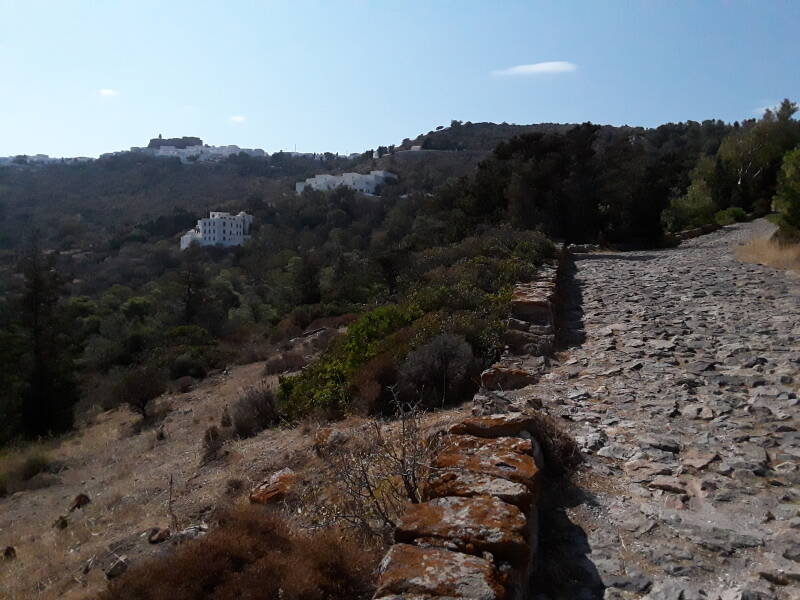
I highly recommend the paper Reading the Apocalypse on the Island of Patmos by Ian Boxall. He was Tutor in New Testament at Chichester Theological College (1992-1994), and Tutorial Fellow in New Testament and Senior Tutor at St Stephen's House, Oxford, and a member of the Theology Faculty at the University of Oxford (1994-2013), and is now Associate Professor of New Testament at the Catholic University of America in Washington D.C.
His paper makes some very interesting points about Revelation and the specific time and place in which it was written, and in which its anticipated readers lived. It compares the new Christian belief to the first century CE religious environment of Patmos. The peak then held a temple to Artemis, dominating the skyline the way the Monastery of Saint John the Theologian does today.
I have made it to the monastery's entrance!
The mosaic depicts John and his scribe Πρόχορος or Prochoros at the cave, with the hand of God reaching out of the sky.

The cave was a small grotto, a small opening within the steep northern slope of the main peak.
In 1088 the Byzantine Emperor Alexios I Komnenos gave Father Ioannis Christodoulos of Asia Minor complete authority over the island of Patmos, along with permission to build a monastery there.
Christodoulos initially planned to build the monastery around the cave. But when he arrived, he changed the plan to build the main monastery at the peak where it would be much better defended against raids. There were ruins of a fourth-century basilica at the peak, built on ruins of the earlier temple to Artemis. His chosen location was a good one, because attacks came, including those from the supposed Christian armies of western Europe.
Christodoulos built a hermitage around the cave. He started by building a chapel that closed off the cave. The cave and the added chapel form a two-nave church. He named the chapel in honor of Saint Anne, the mother of Mary and grandmother of Jesus. Anne was also the name of his mother, and of the mother of Emperor Alexios. So, yes, keep everyone's mother happy.
The dual chapel has icons, silver lamps, and air thick with incense.
You can't take any pictures within the cave area, so here are scans of some postcards.
In this first one the original cave is off to the right. The irregular top of the low opening is the original rock face. The barrel-roofed section we're in is the addition that's the chapel of Saint Anne. And this is actually an early 17th century replacement of the original chapel of Saint Anne. There have been additions and modifications all through the centuries, with various figures wanting to contribute something new.
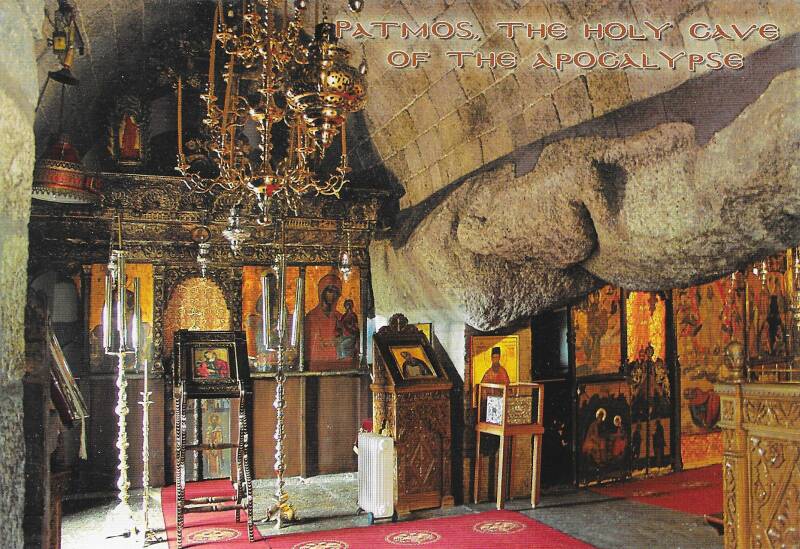
The tradition says that while John was staying in this cave, an earthquake split the rocks forming three narrow crevices in the ceiling of the cave. Three like the Holy Trinity, and like those three-fingered gestures. Then John heard God's voice coming down out of the crevices.
This postcard is looking more directly into the cave from the added chapel. You can see the cave's rough natural ceiling with its crevices. The floor has been heavily modified and is largely man-made. Three or four more benches stand behind the two you can see here. Notice the small fence enclosing the far corner under several silver oil lamps, the silver oval on the cave wall next to the fence, and the white and yellow fabric on the far wall.
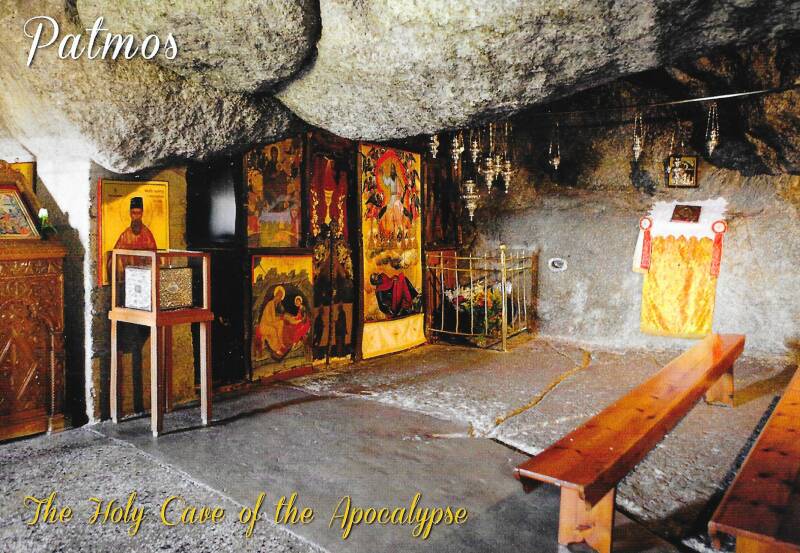
Here is a slightly better view of those features, including the three-part crevices in the ceiling. There are two cavities in the wall, now lined with silver fixtures. The larger is at floor level within the fence. It is said to be where John would lay his head while stretched out on the floor experiencing visions. The smaller one is said to be where he put his hand to get down and back up off the floor. The Holy Headrest and the Holy Handgrip, if you will.
To their right is what is said to be the writing station of Prochoros. The white cloth covers a fairly smooth area waist high and inclined at about 45°.

Yes, the traditions have led to multiple embellishments. The headrest and handgrip, and Prochoros — none of those were mentioned in the text of Revelation. Some of the traditions are based on popular legends, with some of those coming from the fifth century text Acts of the Holy Apostle and Evangelist John the Theologian by his disciple Prochoros.
The large icon, though, is straight out of the text. See, it's good to do your reading on the ferry ride.

I was in the Spirit on the Lord's day, and heard behind me a great voice, as of a trumpet, Saying, I am Alpha and Omega, the first and the last: and, What thou seest, write in a book, and send it unto the seven churches which are in Asia; unto Ephesus, and unto Smyrna, and unto Pergamos, and unto Thyatira, and unto Sardis, and unto Philadelphia, and unto Laodicea. And I turned to see the voice that spake with me. And being turned, I saw seven golden candlesticks; And in the midst of the seven candlesticks one like unto the Son of man, clothed with a garment down to the foot, and girt about the paps with a golden girdle. His head and his hairs were white like wool, as white as snow; and his eyes were as a flame of fire; And his feet like unto fine brass, as if they burned in a furnace; and his voice as the sound of many waters. And he had in his right hand seven stars: and out of his mouth went a sharp two-edged sword: and his countenance was as the sun shineth in his strength. And when I saw him, I fell at his feet as dead. And he laid his right hand upon me, saying unto me, Fear not; I am the first and the last: I am he that liveth, and was dead; and, behold, I am alive for evermore, Amen; and have the keys of hell and of death. Write the things which thou hast seen, and the things which are, and the things which shall be hereafter; The mystery of the seven stars which thou sawest in my right hand, and the seven golden candlesticks. The seven stars are the angels of the seven churches: and the seven candlesticks which thou sawest are the seven churches.
— Revelation 1:10-20
As an icon, instances of it always closely follow a standardized form. There's no room for bold innovation in the field of icons. One with John lying the other way, with his head on the right, or any other seemingly minor changes, simply wouldn't be considered a valid image of this.

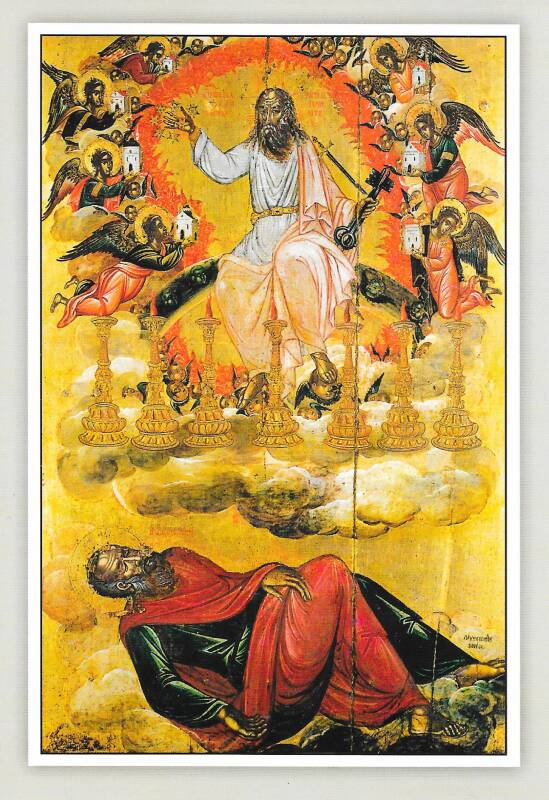
There's a wonderful view from the Monastery of the Cave down over Skala and the harbor. Although the next day I would continue on to the Monastery at the peak and an even better view of the island and the surrounding Aegean.

I had taken the shorter but steeper and much rougher footpath going up to the cave. I walked back down on the road. Along the way I saw a small roadside shrine as you find throughout Greece, especially on the mainland but also common on some islands.
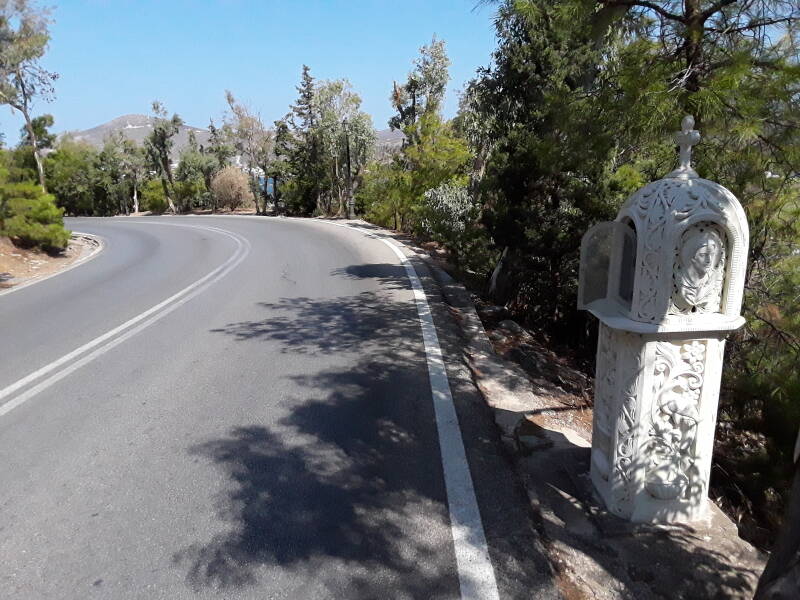
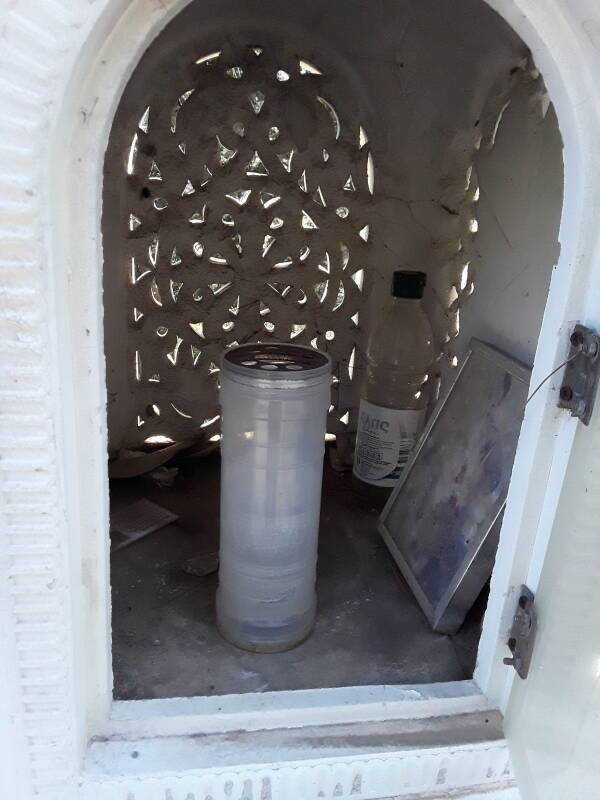
I had stayed at the cave until almost closing time, but I got back to Skala in time to get lunch. Refreshing cold retsina and chicken souvlaki. Retsina is dry white wine with pine resin. Just a tiny splash of turpentine.
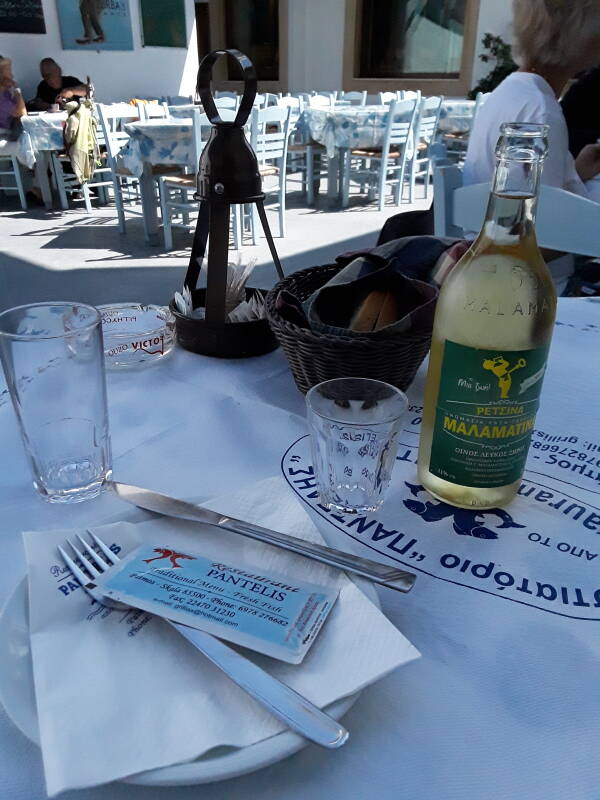
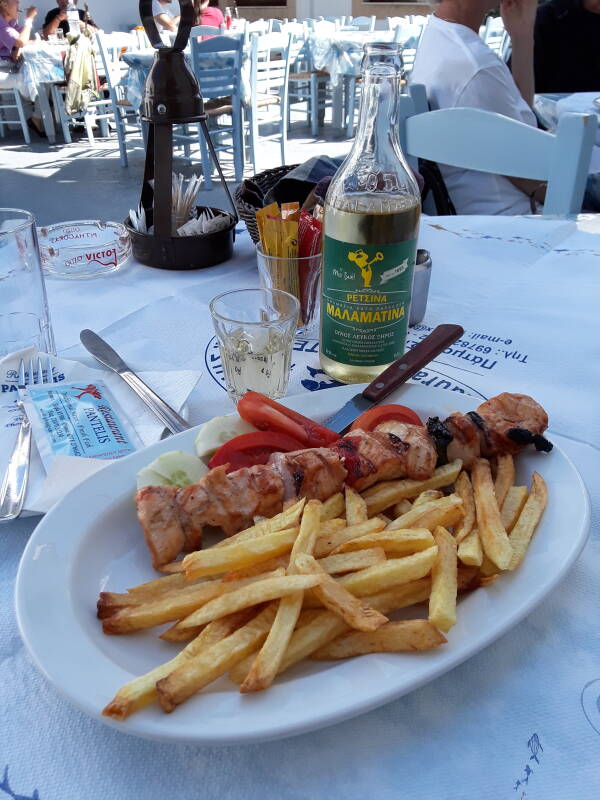

And, as usual, they brought out an added treat at the end — cherries.
Or, Continue Through Greece:
